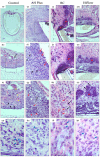Subcutaneous Implantation Assessment of New Calcium-Silicate Based Sealer for Warm Obturation
- PMID: 33401424
- PMCID: PMC7824331
- DOI: 10.3390/biomedicines9010024
Subcutaneous Implantation Assessment of New Calcium-Silicate Based Sealer for Warm Obturation
Abstract
Calcium silicate-based sealers were recently introduced as a new class of endodontic sealers, with potential further benefits due to their bioactivity. The aim of this study was to evaluate the biocompatibility of two new hydraulic calcium silicate-based sealers, TotalFill BC Sealer (FKG, La Chaux-des-Fonds, Switzerland) and TotalFill BC Sealer HiFlow (FKG, La Chaux-des-Fonds, Switzerland) through subcutaneous implantation in connective tissue of rats. Subcutaneous implantation was performed in 16 young Wistar rats. Four polyethylene tubes were implanted in each animal, one empty to serve as a control, and three filled with tested sealers: AH Plus as reference (Dentsply DeTrey, Konstanz, Germany), TotalFill BC Sealer (BC) and TotalFill BC Sealer HiFlow (HiFlow). Eight rats were euthanized at 8 days and the remaining eight at 30 days. Hematoxylin-eosin staining was used to score the inflammatory reaction, macrophage infiltrate and to measure the thickness of the fibrous capsule. von Kossa staining was performed to evaluate the mineralization level. Kruskal-Wallis test followed by Dunn's post hoc test was used to analyze non-parametric data. To analyze the influence of the implantation time within each material, a Mann-Whitney U test was performed. At eight days post-implantation, AH Plus induced a more intense inflammatory reaction when compared both with the control (p ≤ 0.001) and BC (p ≤ 0.01). HiFlow presented a higher score of macrophage infiltrate than control (p ≤ 0.01) and BC (p ≤ 0.05). The fibrous capsule thickness in this period was significantly higher for the BC group when compared to control (p ≤ 0.01) and AH Plus (p ≤ 0.05). The mineralization potential was higher for the HiFlow group when compared with the control (p ≤ 0.001) and AH Plus (p ≤ 0.001). At 30 days post-implantation, the score for the inflammatory reaction remained higher for the AH Plus group when compared both to control (p ≤ 0.01) and BC (p ≤ 0.001). The macrophage infiltrate of the HiFlow was significantly higher than control (p ≤ 0.001) and AH Plus groups (p ≤ 0.01), additionally, the fibrous capsule of the BC (p ≤ 0.001) and HiFlow (p ≤ 0.01) groups were both thicker than control. Mineralization potential was observed only on BC (p ≤ 0.05) and HiFlow groups (p ≤ 0.001), when compared to control). BC exhibited the best biocompatibility performance of all tested sealers and HiFlow provided the greatest induction of mineralized tissues. Both TotalFill BC Sealer and TotalFill BC Sealer HiFlow are biocompatible and show potential bioactivity when implanted in the subcutaneous tissue. Bioactivity was not found in AH Plus.
Keywords: bioactivity potential; biocompatibility; calcium silicate-based sealers; endodontic sealers; endodontics; subcutaneous implantation.
Conflict of interest statement
The authors have stated explicitly that there are no conflicts of interest in connection with this article.
Figures





Similar articles
-
Comparative Cytocompatibility and Mineralization Potential of Bio-C Sealer and TotalFill BC Sealer.Materials (Basel). 2019 Sep 22;12(19):3087. doi: 10.3390/ma12193087. Materials (Basel). 2019. PMID: 31546696 Free PMC article.
-
Biocompatibility and Bioactive Potential of New Calcium Silicate-based Endodontic Sealers: Bio-C Sealer and Sealer Plus BC.J Endod. 2020 Oct;46(10):1470-1477. doi: 10.1016/j.joen.2020.07.011. Epub 2020 Jul 17. J Endod. 2020. PMID: 32682789
-
Bioactivity and Element Composition of Three Endodontic Root Canal Sealers.J Contemp Dent Pract. 2025 Jan 1;26(1):62-70. doi: 10.5005/jp-journals-10024-3791. J Contemp Dent Pract. 2025. PMID: 40254872
-
Premixed calcium silicate-based root canal sealers have better biological properties than AH Plus: A systematic review and meta-analysis of in vivo animal studies and in vitro laboratory studies.J Conserv Dent Endod. 2024 Apr;27(4):345-359. doi: 10.4103/JCDE.JCDE_24_24. Epub 2024 Apr 5. J Conserv Dent Endod. 2024. PMID: 38779200 Free PMC article. Review.
-
Composition and physicochemical properties of calcium silicate based sealers: A review article.J Clin Exp Dent. 2017 Oct 1;9(10):e1249-e1255. doi: 10.4317/jced.54103. eCollection 2017 Oct. J Clin Exp Dent. 2017. PMID: 29167717 Free PMC article. Review.
Cited by
-
In Vivo Evaluation of Tissue Biocompatibility of Calcium Silicate-based and Epoxy Resin-based Sealers.Iran Endod J. 2024;19(4):278-286. doi: 10.22037/iej.v19i4.45646. Iran Endod J. 2024. PMID: 39469510 Free PMC article.
-
The Effects of 3-Dimensional Bioprinting Calcium Silicate Cement/Methacrylated Gelatin Scaffold on the Proliferation and Differentiation of Human Dental Pulp Stem Cells.Materials (Basel). 2022 Mar 15;15(6):2170. doi: 10.3390/ma15062170. Materials (Basel). 2022. PMID: 35329621 Free PMC article.
-
Present status and future directions: Hydraulic materials for endodontic use.Int Endod J. 2022 May;55 Suppl 3(Suppl 3):710-777. doi: 10.1111/iej.13709. Epub 2022 Mar 17. Int Endod J. 2022. PMID: 35167119 Free PMC article. Review.
-
Models for Oral Biology Research.Biomedicines. 2022 Apr 20;10(5):952. doi: 10.3390/biomedicines10050952. Biomedicines. 2022. PMID: 35625688 Free PMC article.
-
The osteoinductive potential of different root-end filling materials in a rat femur model.Sci Rep. 2024 Jan 24;14(1):2078. doi: 10.1038/s41598-024-52584-5. Sci Rep. 2024. PMID: 38267563 Free PMC article.
References
LinkOut - more resources
Full Text Sources
Other Literature Sources

